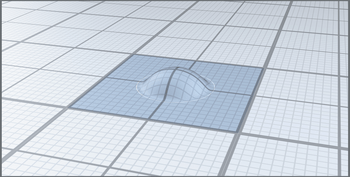Bump function
In mathematics, a bump function (also called a test function) is a function on a Euclidean space which is both smooth (in the sense of having continuous derivatives of all orders) and compactly supported. The set of all bump functions with domain forms a vector space, denoted or . The dual space of this space endowed with a suitable topology is the space of distributions.

Examples
The function given by
is an example of a bump function in one dimension. It is clear from the construction that this function has compact support, since a function of the real line has compact support if and only if it has bounded and closed support. The proof of smoothness follows along the same lines as for the related function discussed in the Non-analytic smooth function article. This function can be interpreted as the Gaussian function scaled to fit into the unit disc: the substitution corresponds to sending to .
A simple example of a bump function in variables is obtained by taking the product of copies of the above bump function in one variable, so
Existence of bump functions

It is possible to construct bump functions "to specifications". Stated formally, if is an arbitrary compact set in dimensions and is an open set containing , there exists a bump function which is on and outside of . Since can be taken to be a very small neighborhood of , this amounts to being able to construct a function that is on and falls off rapidly to outside of , while still being smooth.
The construction proceeds as follows. One considers a compact neighborhood of contained in , so . The characteristic function of will be equal to on and outside of , so in particular, it will be on and outside of . This function is not smooth however. The key idea is to smooth a bit, by taking the convolution of with a mollifier. The latter is just a bump function with a very small support and whose integral is . Such a mollifier can be obtained, for example, by taking the bump function from the previous section and performing appropriate scalings.
Properties and uses
While bump functions are smooth, they cannot be analytic unless they vanish identically. This is a simple consequence of the identity theorem. Bump functions are often used as mollifiers, as smooth cutoff functions, and to form smooth partitions of unity. They are the most common class of test functions used in analysis. The space of bump functions is closed under many operations. For instance, the sum, product, or convolution of two bump functions is again a bump function, and any differential operator with smooth coefficients, when applied to a bump function, will produce another bump function.
The Fourier transform of a bump function is a (real) analytic function, and it can be extended to the whole complex plane: hence it cannot be compactly supported unless it is zero, since the only entire analytic bump function is the zero function (see Paley–Wiener theorem and Liouville's theorem). Because the bump function is infinitely differentiable, its Fourier transform must decay faster than any finite power of for a large angular frequency .[1] The Fourier transform of the particular bump function
from above can be analyzed by a saddle-point method, and decays asymptotically as
for large .[2]
References
- K. O. Mead and L. M. Delves, "On the convergence rate of generalized Fourier expansions," IMA J. Appl. Math., vol. 12, pp. 247–259 (1973) doi:10.1093/imamat/12.3.247.
- Steven G. Johnson, Saddle-point integration of C∞ "bump" functions, arXiv:1508.04376 (2015).